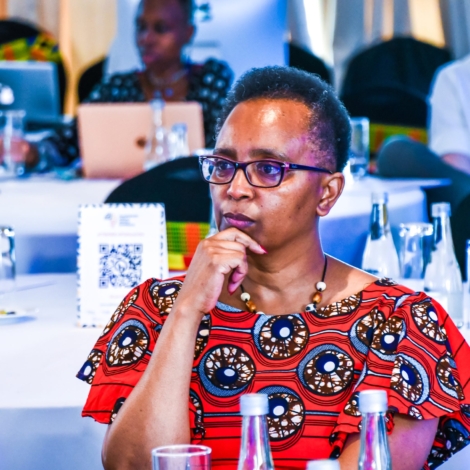Dr. Moses Ochora was on night duty on a cold morning when the emergency phone rang alerting him of the arrival of a preterm baby delivered in one of the remote satellite facilities in western Uganda, the region where he works. The baby weighed slightly more than two pounds and arrived in a boda boda taxi at 5 AM.
“The baby was very cold, was struggling to breathe and the hospital had lost power the previous day. The generator was not strong enough to support an oxygen concentrator. This requires a lot of innovation,” Dr. Ochora, a pediatrician at Mbarara University hospital in Uganda, says.
The baby survived, though with multiple infections and a jaundice attack. Dr. Ochora reported the incident at the inaugural Transforming African Medtech Conference in Nairobi, Kenya. The conference was hosted by Villgro Africa and Jaza Rift Ventures, in collaboration with Kenyatta University and Rice360 Institute for Global Health Technologies. Dr. Ochora joined experts from Uganda and Kenya at the conference to describe a nascent medical technology sector rising in Africa. Their reports portray the consequences of medical treatment in low-income communities, while recognizing home-grown technological innovation and the birth of a movement.
Dr. Ochora’s story is not an outlier. Close calls are common in rural African hospitals. Shortages in basic equipment hamper medical treatment, even after the influx of technology and funding ushered in during the COVID-19 pandemic. Before Covid-19, Kenya, for example, had a paltry supply of oxygen cylinders in hospitals and less than 500 equipped ICU beds for a population of over 50 million people.
The situation improved slightly during the pandemic with increased efforts to import medical devices, and to design and manufacture equipment regionally. Such efforts include a multispectral approach towards developing an oxygen ventilator. The work on the ventilator exemplifies challenges that face the African medical technology sector.
However, the rollout of the ventilator hit headwinds, says Professor Paul Wainana, Vice Chancellor of Kenyatta University.
“We are frustrated because we faced many regulatory and certification challenges leaving the device at the piloting stage,” Dr. Wainana said at the Medtech Conference. “We need to develop innovations for Africa that go beyond the pilot stage. This means we need to find the right balance in developing strategies for commercialization and finding a way past the regulators and verification.”
While Kenya struggled, South Africa found success in deploying ventilators during the pandemic. What made the southern nation’s initiative successful was a well-organized collaboration between sectors. The South African National Ventilator Project convened government departments, universities, private industry and medical professionals to deploy a functional device to public hospitals within months.
“South Africans succeeded because they brought everybody to the table. People from the motor vehicle industry, from space industry, from the medical and all government agencies. Everyone brought their expertise. They were more efficient,” Dr. Victor Konde, the scientific officer at the United Nations Economic Commission for Africa, said at the Medtech Conference.
Many African countries have had very little influence in the innovation and trade of medical devices, yet they are net importers, Dr. Konde says.
Africa imports about (USD) $4 billion worth of medical devices, representing about 90 percent of its needs. The nations with the highest percentage of the continent’s imports are South Africa (18%), Egypt (12%), Morocco (8%) and Kenya (2.5%), according to data released during the Medtech Conference.
The pipeline of medical devices does not flow just one way, however. A small, but growing, medical devices industry in Africa exports (USD) $600 million in equipment every year, representing 0.3 percent of the global sector.
There have been innovative initiatives geared towards increasing the number of devices in hospitals. The private sector has taken the largest share of innovation followed by universities.
“Africa should not miss such lucrative markets with high potential to improve healthcare services for millions of its people. Collaborations amongst various stakeholders, including governments, regulators, academia and industry, have the potential to develop solutions to address the diverse healthcare challenges faced on the African continent, including the development and manufacture of medical devices,” says Wambui Gachiengo, Villgro Africa’s Chief Technology Officer.
In the Kenyan coastal tourist town of Kilifi, Ronnek Vora runs a family owned Revival Healthcare company which has contributed greatly to Kenya’s share of the medical device export market. The company got its start as a syringe maker, then grew through innovative research contracts in Africa, and partnerships with USAID and the Bill & Melinda Gates Foundation.
The company has been instrumental in the development of various medical devices ranging from syringes, test and diagnostic kits and surgery tools for the African market.
“When COVID-19 came, we sat with our R&D team and asked ourselves what we could do to solve the challenge the country, continent and the world was facing. So, before the pandemic, we were producing 3 million vaccine syringes, but we ramped up capacity to 30 million exporting across the globe,” Vora says.
Gearbox Kenya is a similar initiative. Gearbox is a makerspace that has been producing medical devices like orthopedic beds for various hospitals through 3D printing and other methods. Kamau Gachigi, the executive director of Gearbox, observes that through various collaborations, the entity has managed to provide a space where mechanical engineers can innovate and commercialize their ideas.
The funding scape is not great also. For ideas generated in the pilot stage, innovators find it hard to move to the next level. According to Jaza Rift Ventures General Partner, Sewu-Steve Tawia, investment in the medical devices segment of Africa’s startup space has the potential to hit (USD) $259 billion by 2030. Currently, the sector has attracted (USD) $500 million in investments.
“The future of the medical devices sector startup space is artificial intelligence (AI). AI in healthcare could include tasks that range from simple to complex—everything from answering the phone to medical record review, population health trending and analytics, therapeutic drug and device design, reading radiology images, making clinical diagnoses and treatment plans, and even talking with patients,” Tawia sys. This, he says needs a financial boost.
Prof Wainaina, the VC of Kenyatta University, has called on the government to increase its commitment in the medical devices sector through allocating more budget to research and development of the sector. “We believe that by applying the best that technology has to offer to the manufacturing sector, including AI and robotics, we can develop much-needed medical devices that can be distributed across Africa at scale and at an affordable cost. The conference has served as a catalyst for capturing these ideas and inspiring action that will now make them a reality,” Wainaina noted.
As the industry grows, players in the industry are reckoning the need to develop an interlink between the huge bill associated with health burden in the continent, the technical knowledge required and available among innovators and the economics required to support the industry.
Editor’s note: Villgro Africa is a partner to the American Society of Mechcanical Engineers Innovation Showcase (ASME ISHOW). Engineering for Change and ISHOW are both under the umbrella organization ASME.
About the Author
Kimani Chege is a journalist based in Nairobi Kenya and a 2021 Engineering for Change Editorial Fellow. He specializes in science, technology and climate change. Twitter: @Kymcee LinkedIn: Kimani Chege.

